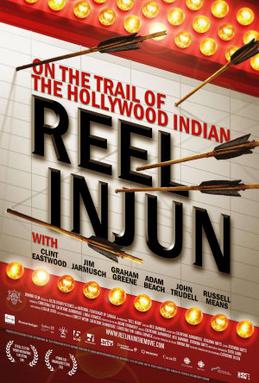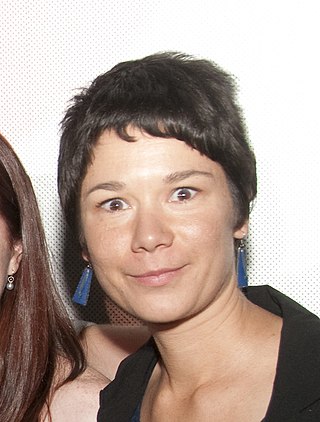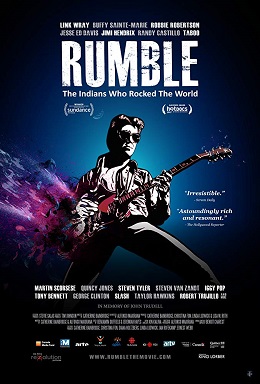Related Research Articles
The Native American Film and Video Festival was a noncompetitive showcase of film, video and audio productions. It was held biennially in New York City from 1997 to 2011. Each festival screened between 50 and 80 documentaries, short features and animations, introduced by their producers and members of the native communities represented. Works to be featured in a given festival were chosen by a team of selectors made up of media makers and cultural activists from among indigenous peoples of the Americas and the program staff of the Film and Video Center of the Smithsonian Institution National Museum of the American Indian. Selectors have included indigenous film makers such as Chris Eyre, Randy Redroad, and Nora Naranjo-Morse, and Native American cultural experts and academics such as G. Peter Jemison, Beverly Singer, and Paul Apodaca.

The Redding Rancheria is a federally recognized tribe with a reservation in Shasta County, Northern California. The 31-acre site (13 ha) of the Redding Rancheria was purchased in 1922 by the Bureau of Indian Affairs in order to provide Indigenous peoples with a place to camp and live. They had been made landless by European-American settlers in the area. Three groups of Native Americans in the area organized as a tribe and were recognized in 1979.
Plastic shamans, or plastic medicine people, is a pejorative colloquialism applied to individuals who are attempting to pass themselves off as shamans, holy people, or other traditional spiritual leaders, but who have no genuine connection to the traditions or cultures they claim to represent. In some cases, the "plastic shaman" may have some genuine cultural connection, but is seen to be exploiting that knowledge for ego, power, or money.

Stereotypes of Indigenous peoples of Canada and the United States of America include many ethnic stereotypes found worldwide which include historical misrepresentations and the oversimplification of hundreds of Indigenous cultures. Negative stereotypes are associated with prejudice and discrimination that continue to affect the lives of Indigenous peoples.
500 Nations is an eight-part American documentary television series that was aired on CBS in 1995 about the Native Americans of North and Central America. It documents events from the Pre-Columbian era to the end of the 19th century. Much of the information comes from text, eyewitnesses, pictorials, and computer graphics. The series was hosted by Kevin Costner, narrated by Gregory Harrison, and directed by Jack Leustig. It included the voice talents of Eric Schweig, Gordon Tootoosis, Wes Studi, Cástulo Guerra, Tony Plana, Edward James Olmos, Patrick Stewart, Gary Farmer, Tom Jackson, Tantoo Cardinal, Dante Basco, Sheldon Peters Wolfchild, Tim Bottoms, Michael Horse, Graham Greene, Floyd Red Crow Westerman, Amy Madigan, Frank Salsedo, and Kurtwood Smith. The series was written by Jack Leustig, Roberta Grossman, Lee Miller, and W. T. Morgan, with John M. D. Pohl.
The imagineNATIVE Film + Media Arts Festival is the world's largest Indigenous film and media arts festival, held annually in Toronto. The festival focuses on the film, video, radio, and new media work of Indigenous, Aboriginal and First Peoples from around the world. The festival includes screenings, parties, panel discussions, and cultural events.

Reel Injun is a 2009 Canadian documentary film directed by Cree filmmaker Neil Diamond, Catherine Bainbridge, and Jeremiah Hayes that explores the portrayal of Native Americans in film. Reel Injun is illustrated with excerpts from classic and contemporary portrayals of Native people in Hollywood movies and interviews with filmmakers, actors and film historians, while director Diamond travels across the United States to visit iconic locations in motion picture as well as American Indian history.

The portrayal of Native Americans in television and films concerns indigenous roles in cinema, particularly their depiction in Hollywood productions. Especially in the Western genre, Native American stock characters can reflect contemporary and historical perceptions of Native Americans and the Wild West.

Photography by indigenous peoples of the Americas is an art form that began in the late 19th century and has expanded in the 21st century, including digital photography, underwater photography, and a wide range of alternative processes. Indigenous peoples of the Americas have used photography as a means of expressing their lives and communities from their own perspectives. Native photography stands in contrast to the ubiquitous photography of indigenous peoples by non-natives, which has often been criticized as being staged, exoticized, and romanticized.

Sterlin Harjo is a Seminole filmmaker. He has directed three feature films, a feature documentary, and the FX comedy drama series Reservation Dogs, all of them set in his home state of Oklahoma and concerned primarily with Native American people and content.
Loretta Sarah Todd is a Canadian Indigenous film director. Todd has directed over 100 projects including documentaries, video games, animated media, and television shows.
Sonia Boileau is a Canadian First Nations filmmaker belonging to the Mohawk Nation of the Haudenosaunee Confederacy.
Elle-Máijá Apiniskim Tailfeathers is a Blackfoot and Sámi filmmaker, actor, and producer from the Kainai First Nation in Canada. She has won several accolades for her film work, including multiple Canadian Screen Awards.

Lisa Jackson is a Canadian Screen Award and Genie Award-winning Canadian and Anishinaabe filmmaker. Her films have been broadcast on APTN and Knowledge Network, as well as CBC's ZeD, Canadian Reflections and Newsworld and have screened at festivals including HotDocs, Edinburgh International Film Festival, Melbourne, Worldwide Short Film Festival and Berlin International Film Festival.
Michelle St. John is an actress, singer, producer and director who has been involved in creative projects in theatre, film, television and music since the 1980s. Her directorial debut, Colonization Road, is a 2016 feature-length documentary that premiered at imagineNATIVE Film and Media Arts Festival.

Victor Masayesva Jr. is a Hopi filmmaker, video artist, and photographer. Born on the Hopi Reservation of Arizona and growing up in Hotevilla, Masayesva's artistic career reflects his active participation with the Hopi community and his body of work promoting Hopi culture and worldview. Scholar Martin Padget considers Masayesva "one of the most influential Indigenous filmmakers and photographers of his generation." Masayesva's films and photographs are diverse and complex in nature, often employing diverse visual languages, and an experimental approach towards media. The majority of his films are in the Hopi language and are destined for his community, especially to pass-on traditional teachings to youth. Masayesva has also been personally involved in promoting indigenous media, both in the United States and internationally.

Tracy Rector is an American filmmaker, curator, and arts advocate based in Seattle, Washington. She is the executive director and co-founder of Longhouse Media, an Indigenous and POC media arts organization and home of the nationally acclaimed program Native Lens. She has worked as an education consultant at the Seattle Art Museum, as a native naturalist for the Olympic Sculpture Park, and has developed curriculum for IslandWood, an environmental education center.

Rumble: The Indians Who Rocked The World is a 2017 Canadian documentary film directed by Catherine Bainbridge and co-directed by Alfonso Maiorana. The film profiles the impact of Indigenous musicians in Canada and the US on the development of rock music. Artists profiled include Charley Patton, Mildred Bailey, Link Wray, Jesse Ed Davis, Stevie Salas, Buffy Sainte-Marie, Robbie Robertson, Randy Castillo, Jimi Hendrix, Taboo and others. The title of the film is a reference to the pioneering instrumental "Rumble", released in 1958 by the American group Link Wray & His Ray Men. The instrumental piece was very influential on many artists.
Alexandra Lazarowich is a Cree director and producer from Edmonton, Alberta, Canada. Initially working as a child actress and model, by the age of 27 she had produced 9 films. She is the producer for the Canadian Broadcasting Corporation's Still Standing.
References
- Imagining Indians: Film information Retrieved on July 20, 2007
- Victor Masayesva, Jr.: Photography and film-making Basic Info Retrieved on March 14, 2010
- Hearne, Joanna. 2005. "John Wayne's teeth: Speech, sound and representation in "Smoke signals" and "Imagining Indians"." Western Folklore 64 (3/4): 189–208.